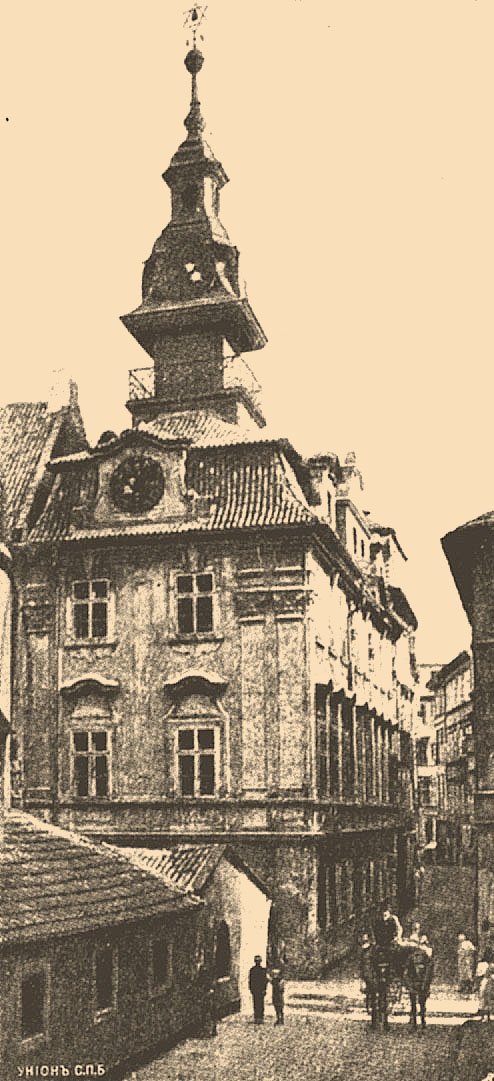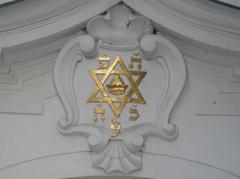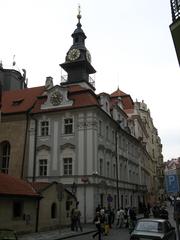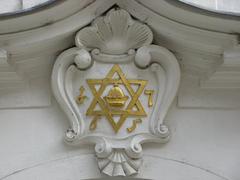
Jewish Town Hall Prague: Visiting Hours, Tickets, and Historical Significance
Date: 15/06/2025
Introduction
Nestled in the center of Prague’s Josefov district, the Jewish Town Hall (Židovská radnice) is a distinguished symbol of Jewish communal life, resilience, and cultural heritage. With its origins in the late 16th century and its famed dual clocks, the Town Hall stands as a testament to over four centuries of Jewish self-governance and perseverance amidst adversity. While interior access is generally restricted, its striking Rococo façade and prominent location make it a key highlight of Prague’s Jewish Quarter. This guide provides a detailed overview of the Town Hall’s history, architectural features, visitor information—including hours and ticketing—and practical travel tips for exploring Josefov and its remarkable Jewish heritage sites.
For the latest visitor information, consult the Jewish Museum Prague official website, as well as reputable travel sources (Wikipedia, Just a Pack, Alle Travel).
Contents
- Introduction
- Historical Overview
- Architectural Features
- Cultural Significance
- Relationship to Nearby Heritage Sites
- Visitor Information
- Travel Tips and Nearby Attractions
- Frequently Asked Questions (FAQs)
- Images and Media
- Sources
Historical Overview
Early Jewish Settlement and the Formation of Josefov
Jewish life in Prague dates back to at least 965 CE, as recorded by the traveler Ibrahim ibn Yaqub (Wikipedia). Over centuries, the Jewish community endured both periods of prosperity and hardship, eventually being confined to the walled ghetto of Josefov after the 11th century. Despite restrictions, Josefov evolved into a vibrant center of Jewish culture, scholarship, and commerce (Expats.cz).
Origins and Architectural Evolution
Commissioned by the philanthropist and mayor Mordechai Maisel in 1586, the Jewish Town Hall was initially constructed in the Renaissance style. After ghetto fires in the 17th and 18th centuries, the building was rebuilt and enhanced with the distinctive Rococo façade visitors see today (Wikipedia; Just a Pack). The Town Hall’s dual clocks—one with Roman numerals, the other with Hebrew numerals running counterclockwise—have become enduring emblems of the community’s unique identity (Alle Travel).
Role as a Center of Jewish Governance
The Town Hall served as the seat of Jewish self-government (kehilla), overseeing taxation, religious courts, charitable activities, and education. It played a pivotal role in safeguarding the rights and autonomy of Prague’s Jews, especially during the community’s golden age under Emperor Rudolf II and the leadership of notable figures like Rabbi Judah Loew ben Bezalel (Expats.cz).
Survival and Continuity
Despite waves of pogroms, expulsions, and the devastation of World War II, the Jewish Town Hall survived, unlike much of the original ghetto. Its preservation testifies to the tenacity of Prague’s Jewish community, who have maintained their traditions and institutions through centuries of adversity (Wikipedia).
Architectural Features
Exterior Design
The Jewish Town Hall’s most striking feature is its Rococo façade, which sets it apart from the predominantly Gothic and Renaissance buildings of the Jewish Quarter. The building is adorned with ornate stucco decorations and pastel tones, and is crowned by an elegant gabled roof (View from Prague).
The Dual Clocks
A distinctive element is the pair of clocks atop the Town Hall. The upper, with Roman numerals, runs clockwise, while the lower, with Hebrew numerals, runs counterclockwise, reflecting the right-to-left reading direction of Hebrew. This rare arrangement symbolizes the synthesis of Jewish and European cultures (Alle Travel).
Interior Layout
The Town Hall’s interior, rarely open to the public, contains meeting rooms and ceremonial spaces historically used for community administration and events. When accessible, these rooms reveal period furnishings and decorative details that echo the building’s administrative and social functions.
Cultural Significance
Center of Self-Governance
As the administrative heart of the Jewish community, the Town Hall was instrumental in maintaining autonomy, organizing education, religious life, and legal affairs (Alle Travel).
Symbol of Identity
The Town Hall, especially its clocks, has become a symbol of Jewish resilience, continuity, and adaptability in a city marked by shifting political and cultural currents.
Contemporary Role
Today, the building houses the Federation of Jewish Communities in the Czech Republic and continues to play a vital role in Prague’s Jewish life.
Relationship to Nearby Heritage Sites
The Jewish Town Hall is surrounded by a constellation of historic sites, including:
- Old-New Synagogue: Europe’s oldest active synagogue.
- Maisel Synagogue: Chronicling Jewish history in Bohemia.
- Pinkas Synagogue: Holocaust memorial.
- Klausen Synagogue: Largest in Josefov, with exhibitions on Jewish customs.
- Old Jewish Cemetery: One of Europe’s oldest Jewish burial grounds (Traveltoblank).
This proximity underscores the Town Hall’s centrality in the daily and spiritual life of Prague’s Jews (Alle Travel).
Visitor Information
Location and Access
- Address: Maiselova 18, Prague 1, Josefov.
- Getting There: Short walk from Old Town Square. Nearest metro: Staroměstská (Line A); tram 22 to Staroměstská (Evendo).
Visiting Hours and Entry
- Interior Access: The Town Hall is generally closed to the public. Occasionally, special events or heritage days allow entry; check official announcements (Salut Bye Bye).
- Exterior Viewing: The façade and clocks can be admired at any time.
Tickets
- Jewish Town Hall: No ticket required for exterior.
- Jewish Quarter Sites: Combined tickets for synagogues and cemetery available from the Jewish Museum. Prices as of 2025: ~600 CZK/adult, 400 CZK/student, 200 CZK/child (Jewish Museum). Tickets valid for seven days, excluding the Old-New Synagogue, which requires a separate ticket.
Accessibility
- Streets: Cobblestone and sometimes uneven.
- Mobility: Some monuments have steps; inquire about accessibility in advance.
Travel Tips and Nearby Attractions
- Photography: Exterior photography is permitted.
- Dress Code: Modest attire recommended for religious sites; head coverings required for men in synagogues and cemeteries.
- Crowds: Visit in the morning for fewer crowds.
- Duration: Allocate at least three hours for the full Jewish Quarter experience.
- Dining: Kosher restaurants such as King Solomon and Dinitz nearby (Traveltoblank).
- Safety: The area is secure, but remain vigilant for pickpockets.
Frequently Asked Questions (FAQs)
Can I visit inside the Jewish Town Hall?
No. The building is generally closed to the public; interior access is only possible during select events.
How can I see the Town Hall?
You can view and photograph the exterior at any time.
Where do I buy tickets for the Jewish Quarter?
Tickets are available at the Jewish Museum Information Centre, Pinkas Synagogue, Klausen Synagogue, and online (Jewish Museum).
What are the opening hours for Jewish Quarter monuments?
Sites are open Sunday–Friday, with hours varying by season (typically 9:00–18:00 in summer, shorter in winter). Closed on Saturdays and Jewish holidays (Prague Experience).
Is the Jewish Quarter accessible?
The quarter is walkable, but cobblestones and steps may challenge those with mobility issues.
Images and Media
[Virtual tour of Prague Jewish Quarter, if available]
Summary and Final Tips
The Jewish Town Hall in Prague stands as a powerful reminder of the city’s Jewish heritage, resilience, and cultural richness. Its eye-catching façade and unique dual clocks are not only architectural highlights but also enduring symbols of Prague’s Jewish community. While interior visits are rare, the Town Hall’s location amidst the historic synagogues and the Old Jewish Cemetery makes it an essential stop on any tour of Josefov.
For the most rewarding experience, combine a visit to the Town Hall’s exterior with a guided tour of the Jewish Quarter, and check official resources for up-to-date information on events and accessibility. Download the Audiala app for audio guides and stay connected for travel tips and updates.
Sources
- History of the Jews in Prague – Wikipedia
- Guide to Josefov – Just a Pack
- Jewish Quarter Attractions – Alle Travel
- Jewish Museum Prague Official Website
- Jewish Quarter Information – Prague Experience
- Jewish Town Hall – Evendo
- Jewish Quarter Guide – Salut Bye Bye

























































































































































































